I baked in pans this weekend. No, there’s nothing wrong with my baking stone. I just have freezers full of baguettes, miches and other hearth breads. Also, I was (and am always) craving scones (using Breadsong’s technique). My wife was urging me to make another whole grain-y sandwich bread. And I wanted a good accompaniment for Pollo Cacciatore. So, it was scones, Hamelman’s Oatmeal Bread and Reinhart’s BBA Focaccia.
Lemony-Cranberry Flaky Scones
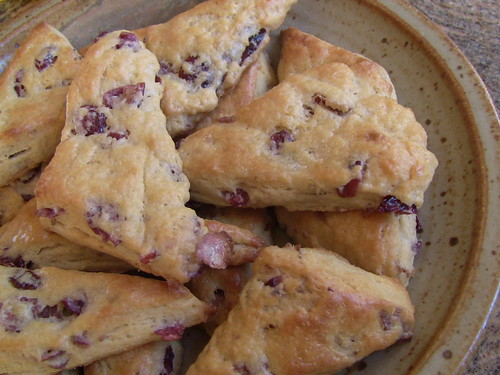 ]
]
Breadsong wrote about flaky scones a couple months ago (http://www.thefreshloaf.com/node/21414/flaky-scones-flavor-variations). I had done a couple variations before (http://www.thefreshloaf.com/node/21496/people-who-live-glass-houses-shouldn039t-stow-scones). This time, I wanted to try a tart and fruity variation. I looked at some lemon scone recipes to see different approaches to getting lemon flavor in scones. Some use lemon zest, some use lemon juice, and some use lemon extract. I used all three.
I also added some dried cranberries, soaked in water overnight. I squeezed out the excess water in a sieve, but the dough was still too moist. So I added some flour in the mix. Next time I’ll reduce the other liquids. The scones came out with the same wonderful texture as before, moist on the inside and crispy on the outside. But they didn’t rise up quite as much. And they could have had a stronger lemon flavor. So next time I’ll use more lemon zest, or maybe candied lemon peel.
I followed Breadsong’s technique. Here’s the formula I recommend, with the adjustments I mentioned above:
1 cups (5 ounces) unbleached all-purpose flour
½ Tbsp baking powder
1/4 tsp kosher salt
scant 1/4 cup golden brown sugar
2 ½ Tbsp cold unsalted butter, cut into 1/2-inch cubes
1/2 cup chopped dried cranberries (soaked overnight in water, excess water squeezed out)
1 teaspoon lemon zest
Just less than 1 cup heavy cream (185 grams)
2 Teaspoons lemon juice
1/2 teaspoon lemon extract
Half-and-half (for brushing)
But even though they could be improved, these scones were dang good.
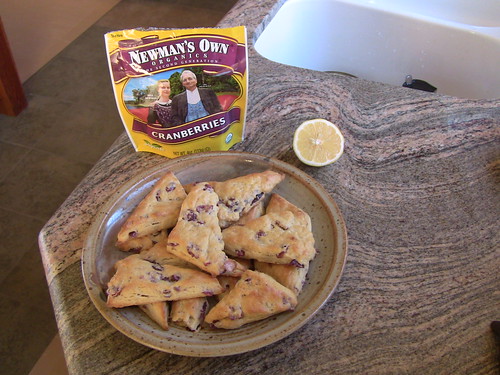
Hamelman’s Oatmeal Bread
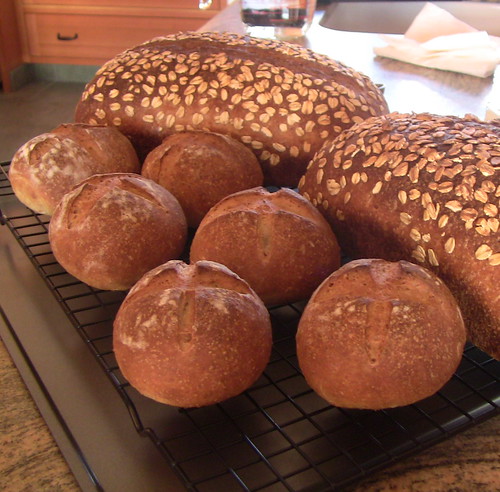
Having enjoyed making –and eating-- AW’s whole wheat bread last week, I decided to try another partially whole grain sandwich bread. I chose the Oatmeal Bread from Hamelman’s Bread: with 25% whole wheat flour and 75% KAF Sir Lancelot. Believe it or not, I made this bread exactly per the formula, with no variations. Believe it? Well, ok…I did substitute molasses for 1/3 of the honey, just because we love the dark, rich flavor.
The dough was fermented for one hour after mixing and kneading, stretched and folded, then refrigerated. It almost tripled by morning. Seriously gassy!
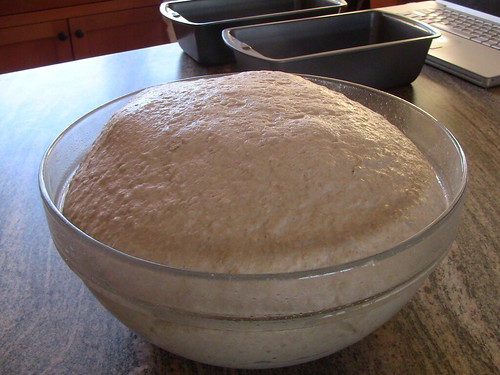
It proofed about 2 ½ hours since it had to get to the temperature the yeasties like. The home-baking formula for this bread in Bread made enough for two loaves in 9 x 5 pans and six 3-ounce rolls. The bread has a wonderful tenderness and a wholesome oatey-wheaty flavor. It was excellent for a dinner of turkey and cole slaw sandwiches. This is a real good sandwich bread and I’ll bake it again.
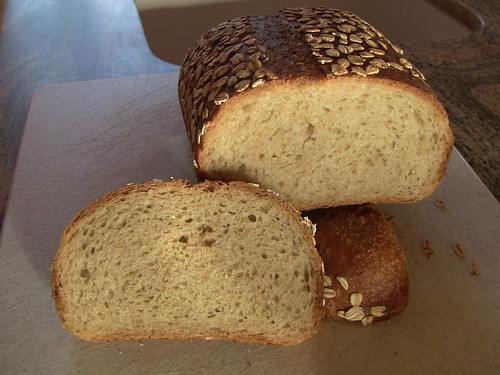
BBA Focaccia
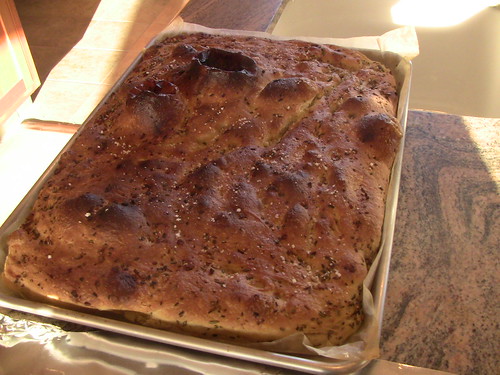
Monday night we are having dinner at home with a friend of a friend, who is a writer for the New York Times, and a serious foodie. In fact, she wrote a wonderful book about the history of Chinese food in the U.S., called The Fortune Cookie Chronicles. I’ll be serving Pollo Cacciatore, my variation on an excellent recipe Brother David shared. I think one needs Focaccia to sop up the delicious gravy.
Since we are traveling back to SF from our North Coast getaway on Monday, and since the Pollo Cacciatore is best re-heated the second day, I made both the chicken and a Rosemary-Garlic Focaccia Sunday. Well, more accurately, the Focaccia dough was mixed, fermented, folded, shaped and slathered with garlic-rosemary oil Saturday evening, and retarded in the fridge overnight.
I looked at a lot of Focaccia recipes and the BBA formula seemed like a good place to start. I figure, if I’ve got the book, I might as well use it. This dough is a monster—sloppy and hard (but fun) to manage. After the third fold and a one-hour rest, it was like a big jiggly pillow. It easily expanded to fill the 17 x 12 sheet pan. When it had warmed a couple hours the next morning, it had serious eruptions.
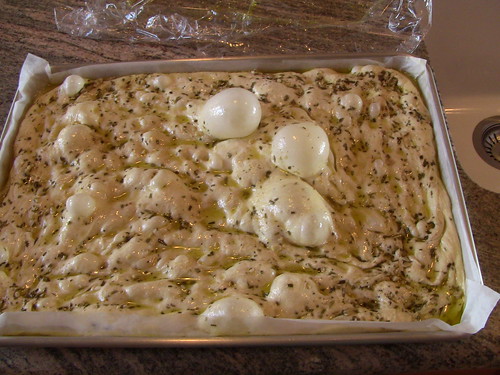
I’ve never seen bread bubbles quite so large. Like volcanos.
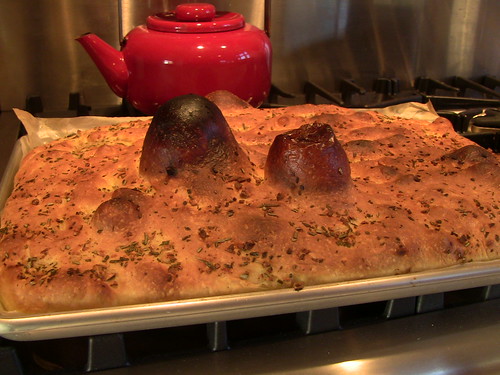
The crumb is airy and tender and the flavor is outstanding with a strong, but not overpowering rosemary and garlic flavor.

We also made fresh pasta today to eat tomorrow with Pollo Cacciatore and re-heated Focaccia. Gonna be good.
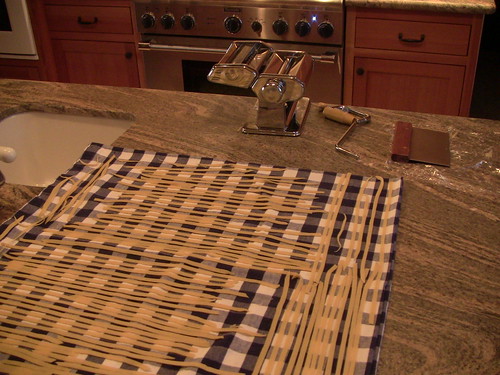
All in all, a good cooking and baking weekend. We also got some good hikes in, and enjoyed the varied animal and bird life of the North Coast. Including a rare sighting of a Flicker right on our meadow.

Happy Presidents’ Day to you all.
Glenn